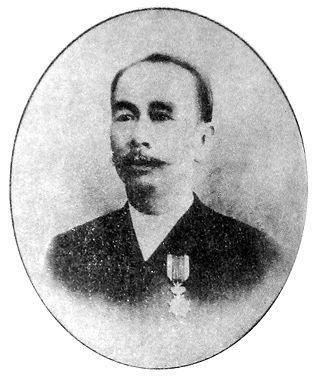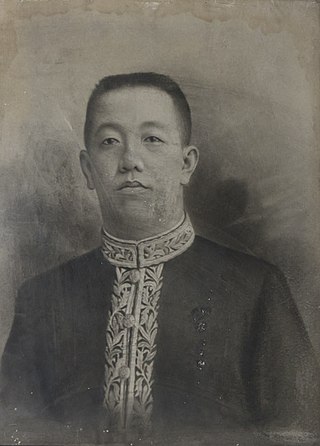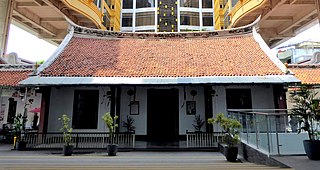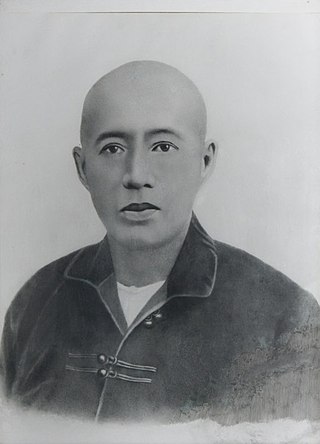Related Research Articles

Phoa Keng Hek Sia was a Chinese Indonesian Landheer (landlord), social activist and founding president of Tiong Hoa Hwe Koan, an influential Confucian educational and social organisation meant to better the position of ethnic Chinese in the Dutch East Indies. He was also one of the founders of Institut Teknologi Bandung.

Khouw Kim An, 5th Majoor der Chinezen was a high-ranking Chinese Indonesian bureaucrat, public figure and landlord who served as the fifth and last Majoor der Chinezen of Batavia, Dutch East Indies. The Chinese Mayoralty was the highest-ranking, Chinese government position in the East Indies with considerable political and judicial jurisdiction over the colony's Chinese subjects. The Batavian Mayoralty was one of the oldest public institutions in the Dutch colonial empire, perhaps second only in antiquity to the viceregal post of Governor-General of the Dutch East Indies.

Kan Hok Hoei Sia, generally known as Hok Hoei Kan or in short H. H. Kan, was a prominent public figure, statesman and patrician landowner of Peranakan Chinese descent in the Dutch East Indies.
Khouw Oen Giok Sia, later more popularly known as Oen Giok Khouw or O. G. Khouw, was a philanthropist and landowner in the Dutch East Indies. He gained notoriety for acquiring Dutch citizenship, thus breaking down the race barriers of colonial society. Today, he is best remembered for his extravagant mausoleum in Petamburan, Jakarta.

Candra Naya is an 18th-century historic building in Jakarta, Indonesia. It was home to the Khouw family of Tamboen, most notably its highest-ranking member: Khouw Kim An, the last Majoor der Chinezen of Batavia. Although among the grandest colonial residences in the capital and protected by heritage laws, the compound was almost completely demolished by its new owners, the conglomerate Modern Group. The main halls have survived only thanks to vocal protests from heritage conservation groups.

The Khouw family of Tamboen was an aristocratic landowning dynasty of bureaucrats and community leaders, part of the Cabang Atas or the Peranakan Chinese gentry of colonial Indonesia.

Tio Tek Ho, 4th Majoor der Chinezen was an ethnic Chinese bureaucrat in the Dutch East Indies who served as the fourth and penultimate Majoor der Chinezen or Chinese headman of Batavia, now Jakarta, capital of Indonesia. This was the most senior position in the Chinese officership, which constituted the Chinese arm of the civil bureaucracy in the Dutch East Indies. As Majoor, Tio was also the ex officio Chairman of the Chinese Council of Batavia, the city's highest Chinese government body.
Khouw Tjeng Tjoan, Luitenant-titulair der Chinezen was a Chinese-Indonesian magnate and landlord.

Sia was a hereditary, noble title of Chinese origin, used mostly in colonial Indonesia. It was borne by the descendants of Chinese officers, who were high-ranking, Chinese civil bureaucrats in the Dutch colonial government, bearing the ranks of Majoor, Kapitein or Luitenant der Chinezen.
Khouw Tjeng Kee, Luitenant-titulair der Chinezen was a Chinese-Indonesian magnate and landlord in Batavia, capital of the Dutch East Indies.

Khouw Yauw Kie, Kapitein der Chinezen (1860–1908), also spelled Khouw Jaouw Kie, Yaouw Kee, was a high-ranking Chinese-Indonesian bureaucrat. He was the first scion of the influential Khouw family of Tamboen to serve on the Chinese Council of Batavia.
Khouw Tjeng Po, Luitenant-titulair der Chinezen was a Chinese-Indonesian magnate and landlord in Batavia, the capital of the Dutch East Indies.

Lie Tjoe Hong, 3rd Majoor der Chinezen was a Chinese-Indonesian bureaucrat who served as the third Majoor der Chinezen, or Chinese headman, of Batavia, now Jakarta, capital of Indonesia. This was the most senior Chinese position in the colonial civil bureaucracy of the Dutch East Indies. As Majoor, Lie was also the Chairman of the Chinese Council of Batavia, the city's highest Chinese government body.
Tan Liok Tiauw Sia was a prominent Chinese-Indonesian landowner, planter and industrial pioneer in the late colonial period, best known today as the last Landheer of Batoe-Tjepper, now the district of Batuceper.

The Cabang Atas —literally 'highest branch' in Indonesian—was the traditional Chinese establishment or gentry of colonial Indonesia. They were the families and descendants of the Chinese officers, high-ranking colonial civil bureaucrats with the ranks of Majoor, Kapitein and Luitenant der Chinezen. They were referred to as the baba bangsawan [‘Chinese gentry’] in Indonesian, and the ba-poco in Java Hokkien.
Khouw is a Dutch-based romanization of the Hokkien surname Xǔ (許) in West Java, Indonesia. In Central and East Java, Kho is a more common romanization.

Tan Tjoen Tiat, 2nd Majoor der Chinezen was a Chinese-Indonesian bureaucrat who served as the second Majoor der Chinezen, or Chinese headman, of Batavia, now Jakarta, capital of Indonesia. This was the most senior Chinese position in the colonial civil bureaucracy of the Dutch East Indies. As Majoor, Tan was also the Chairman of the Chinese Council of Batavia, the city's highest Chinese government body.
Kang Keng Tjong, also spelt Kan Keng Tiong, was a Chinese-Indonesian tycoon and one of the richest men in Batavia, capital of the Dutch East Indies.
Tan Tiang Po, Luitenant der Chinezen, also spelled Tan Tjeng Po, was a colonial Chinese-Indonesian bureaucrat, landowner, philanthropist and the penultimate Landheer (landlord) of the domain of Batoe-Tjepper in the Dutch East Indies.
References
- 1 2 3 4 Knapp, Ronald G. (2015). Chinese Houses of Southeast Asia: The Eclectic Architecture of Sojourners and Settlers. Singapore: Tuttle Publishing. ISBN 9780804844796 . Retrieved 29 November 2016.
- 1 2 3 4 5 6 7 8 9 10 Erkelens, Monique (15 October 2013). The decline of the Chinese Council of Batavia: the loss of prestige and authority of the traditional elite amongst the Chinese community from the end of the nineteenth century until 1942 (PDF). Leiden: Leiden University. Retrieved 28 November 2016.
- 1 2 3 4 5 6 7 8 9 10 Wright, Arnold (1909). Twentieth Century Impressions of Netherlands India. Its History, People, Commerce, Industries and Resources. London: Lloyd's Greater Britain Pub. Co. Retrieved 28 November 2016.
- ↑ Widayati, Naniek (2003). ""Candra Naya Antara Kejayaan Masa Lalu dan Kenyataan Sekarang" [Candra Naya Between The Glory of the Past and The Present Reality]". Dimensi Journal of Architecture and Built Environment (In Indonesian). 31 (2). Retrieved 28 November 2016.
- ↑ Merrillees, Scott (2000). Batavia in Nineteenth Century Photographs. Singapore: Curzon. ISBN 9780700714360 . Retrieved 28 November 2016.
- 1 2 3 "Het particuliere land Tamboen [The estate of Tamboen]". Soerabaijasch Handelsblad. Kolff & Co. 1 October 1943. Retrieved 28 November 2016.
- 1 2 "Javasche Courant". Familiebericht. No. 93. Landsdrukkerij. 22 November 1843. Retrieved 28 November 2016.
- 1 2 3 4 5 Lohanda, Mona (1996). The Kapitan Cina of Batavia, 1837-1942: A History of Chinese Establishment in Colonial Society. Jakarta: Djambatab. ISBN 9789794282571 . Retrieved 28 November 2016.
- 1 2 3 Setyautama, Sam (2008). Tokoh-tokoh etnis Tionghoa di Indonesia. Jakarta: Kepustakaan Populer Gramedia. ISBN 978-9799101259 . Retrieved 28 November 2016.